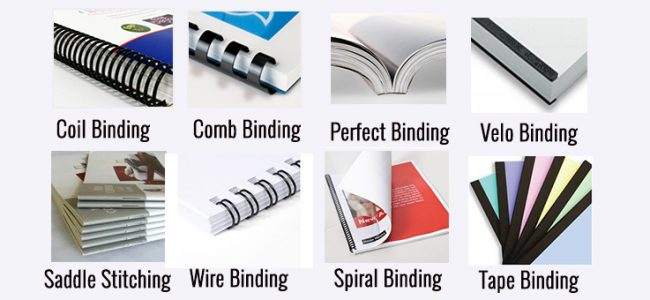With so many Book binding options, it can be tough to determine the best binding method for your project. As long as there has been printing, there has been binding — the way you organize and secure your project for the recipient. There are many different types of binding, ranging from sewing to stapling, and from gluing to rivets to wire.
We recommend you start by considering these factors:
Your Books Functionality
This is a primary consideration. Think about how the printed piece will be used. Does it need to fit in a pocket or sit on someone’s lap? Does it need to support itself when the pages are spread, or fold back on itself when it’s open?
Consider the lifespan of the piece. Is it meant to be viewed once and put aside (or tossed out)? Does it need to last a year as a reference until it can be updated like as magazine, journal ? Or is it meant to be a keepsake, like a diary book ?
Will it be stored in a bookshelf? If so, you may want a spine to give space for copy identifying the piece. Being able to communicate the objectives of your piece with your print provider will help you narrow in on options that best suit your needs.
Your Book Specifications
Not all binding styles adapt to all possible specifications. Page count is a major factor, as is trim size. The type of paper you’re using can affect your binding choice as well. Paper type is a consideration when it comes to the function and durability of the project.
Your Book Printing & Binding Budget
Each binding style comes with its own production needs, and the costs can vary wildly. It’s nearly impossible to rank bindings from most expensive to least expensive, because costs vary based on the specifications and quantity of the project. When discussing the functionality, specifications and quantity with your printer, you can get a better sense of the types of binding that would fit within your budget.
If budget is less of a concern, you can pick and choose the binding that most complements your design. You can even combine binding styles within the same piece. There are more intricate binding techniques that can be done by hand such as a decorative tape on the spine to give the piece a custom look. Keep in mind that some binding styles have limitations, so whatever you choose has to work well with the specifications of your project.
While these guidelines seem general, they illustrate the vast options you have in binding and finishing a printed piece. Consider your goals and design criteria, or you can contact us at MahaMeru Bali Printing to help you navigate to the finished piece.
